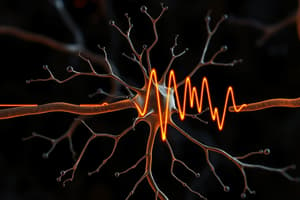Podcast
Questions and Answers
Why is it important to discuss animal research in the context of human neuroimaging?
Why is it important to discuss animal research in the context of human neuroimaging?
To relate human neuroimaging results to animal models for a comprehensive view.
What is the basis of neuronal activity?
What is the basis of neuronal activity?
Sodium-potassium pump in the membrane pumps sodium (Na+) out and potassium (K+) in, resulting in a negative resting potential.
How does the action potential contribute to neuronal communication?
How does the action potential contribute to neuronal communication?
The action potential travels along the axon and contributes to activating the next neuron.
What is optogenetic imaging and how is it used in neuroscience?
What is optogenetic imaging and how is it used in neuroscience?
How can pharmacological manipulations be used to study dopamine transmission in effort-based choice?
How can pharmacological manipulations be used to study dopamine transmission in effort-based choice?
What are the guidelines for the care and use of mammals in neuroscience research?
What are the guidelines for the care and use of mammals in neuroscience research?
How should researchers manage animal pain/distress in neuroscience research?
How should researchers manage animal pain/distress in neuroscience research?
What are some methods for recording and inducing neuronal activity in animals?
What are some methods for recording and inducing neuronal activity in animals?
What are the basic rules for human research ethics in neuroscience?
What are the basic rules for human research ethics in neuroscience?
Flashcards are hidden until you start studying
Study Notes
- Neuronal activity can be recorded and induced in animals through methods such as optogenetic imaging, pharmacological manipulations, and Local Field Potentials (LFPs), Electroencephalography (EEG), and functional magnetic resonance tomography (fMRI) to understand brain function.
- LFPs represent the local activity of a few thousand neurons together, EEG measures the electrical activity on the scalp, and fMRI measures changes in blood flow in response to neural activity.
- Combining LFP recordings with EEG and fMRI in animals helps reveal what these more indirect measures reflect in the human brain.
- Rodent models are valuable for cognitive neuroscience, especially for processes related to old brain structures, but not comparable to humans on the neocortical level and limited in complex cognitive tasks.
- Primate models are more comparable to humans on the neocortical level and valuable for investigating higher cognitive functions, but more time-consuming and challenging to breed and train.
- Human research procedures in neuroscience mostly involve non-invasive methods like EEG and fMRI, while invasive methods like pharmacological intervention and lesions are less common.
- Human research ethics have a long history, with landmarks including the Nuremberg Code (1947), the Declaration of Helsinki (1964), and the Belmont Report (1979), which established principles like respect, beneficence, and justice.
- Basic rules for human research ethics include ethical board approval, informed consent, unbiased selection of subjects, special protection for special groups, subject's right to quit, and minimal risk.
- Historical examples of unethical human research include the Tuskegee Syphilis study (1930s-1970s) and the Belmont Report's response to these issues in 1979.
Studying That Suits You
Use AI to generate personalized quizzes and flashcards to suit your learning preferences.




